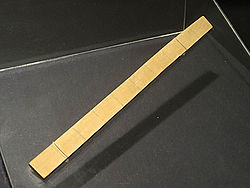| Cun | |||||||||||
|---|---|---|---|---|---|---|---|---|---|---|---|
| Chinese name | |||||||||||
| Chinese | 寸 | ||||||||||
| |||||||||||
| Japanese name | |||||||||||
| Kanji | 寸 | ||||||||||
| Kana | すん | ||||||||||
| |||||||||||
| Korean name | |||||||||||
| Hangul | 치 | ||||||||||
| Hanja | n/a | ||||||||||
| |||||||||||
| Alternative Korean name | |||||||||||
| Hangul | 촌 | ||||||||||
| Hanja | 寸 | ||||||||||
| |||||||||||
| Vietnamese name | |||||||||||
| Vietnamese | thốn | ||||||||||
| Cun | |
|---|---|
 Wooden ruler of the western Han dynasty, unearthed at Jinguan Pass Site in Jinta County | |
| General information | |
| Unit system | Chinese unit |
| Unit of | length |
| Conversions | |
| 1 cun in ... | ... is equal to ... |
| metric (SI) units | 1/30 m ~33.33 mm |
| imperial/US units | ~0.10936 ft ~1.3123 in |
| Tsun | |
|---|---|
 A section of an old Hong Kong ruler, showing the last (10th) cun of a chi. One can see that the chi in that jurisdiction was exactly equal to 14+5/8 of an inch. A metric ruler is shown next to it for comparison. | |
| General information | |
| Unit system | Chinese unit |
| Unit of | length |
| Conversions | |
| 1 tsun in ... | ... is equal to ... |
| metric (SI) units | 0.0371475 m ~37.15 mm |
| imperial/US units | 0.121875 ft 1+37/80 in |
| Sun | |
|---|---|
| Unit system | Japanese unit |
| Unit of | length |
| Conversions | |
| 1 sun in ... | ... is equal to ... |
| metric (SI) units | 1⁄33 m ~30.30 mm |
| imperial/US units | ~0.099419 ft ~1.1930 in |
A cun (Chinese: 寸 ts'wun), often glossed as the Chinese inch, is a traditional Chinese unit of length. Its traditional measure is the width of a person's thumb at the knuckle, whereas the width of the two forefingers denotes 1.5 cun and the width of four fingers (except the thumb) side-by-side is 3 cuns.[1] It continues to be used to chart acupuncture points on the human body, and, in various uses for traditional Chinese medicine.
The cun was part of a larger decimal system. A cun was made up of 10 fen, which depending on the period approximated lengths or widths of millet grains,[2] and represented one-tenth of a chi ("Chinese foot").[3] In time the lengths were standardized, although to different values in different jurisdictions. (See Chi (unit) for details.)
In Hong Kong, using the traditional standard, it measures ~3.715 cm (~1.463 in) and is written "tsun".[4] In the twentieth century in the Republic of China, the lengths were standardized to fit with the metric system, and in current usage in People's Republic of China and Taiwan[citation needed] it measures 3+1/3 cm (~1.312 in).
In Japan, the corresponding unit, sun (寸), was standardized at 1000⁄33 mm (3.03 cm, ~1.193 in, or ~0.09942 ft).
